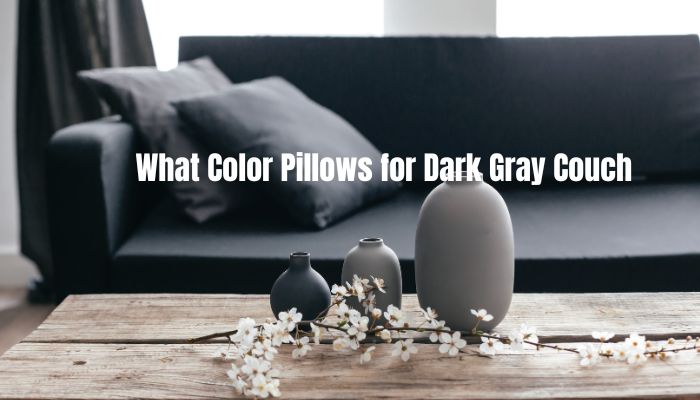Uncover the secrets of picking the right pillow colors for your dark gray couch. Dive in for style inspiration and design principles and create a cozy haven in your living room.
Pillow colors have long been recognized as an essential aspect of interior design, subtly affecting the ambiance of a room and the emotional response of individuals within it. We might sometimes overlook these seemingly minor details. Still, the importance of pillow colors in enhancing your living space cannot be overstated. The right color combination can transform a room from dull and lifeless to vibrant and welcoming, chaotic to calm, or uninspiring to thought-provoking.
Each color has a unique set of connotations and emotions attached to it. When used thoughtfully, pillow colors can evoke moods, convey personality, and tie the aesthetic elements of a room together. From establishing harmony in your space to reflecting your unique taste, the color of your pillows plays a crucial role.
Color Theory 101: Basics for Your Living Room
Understanding color theory is the first step in mastering the art of using pillow colors effectively in your living room. Color theory is a framework that allows us to understand and organize colors based on their relationships and interactions. Here, we outline the basic concepts of color theory and how they can be applied to your living room.
The color wheel is the basis of color theory. It comprises three categories of colors: primary (red, blue, yellow), secondary (green, orange, purple), and tertiary (colors formed by mixing primary and secondary colors). This arrangement allows us to understand which colors are complementary (opposite each other on the wheel) and analogous (next to each other on the wheel).
When selecting pillow colors for your living room, consider the color scheme you aim for. A monochromatic scheme uses different tints, shades, and tones within the same color family, creating a cohesive and sophisticated look. An analogous scheme involves colors adjacent to the color wheel, resulting in harmonious combinations. A complementary scheme, on the other hand, brings together two colors from opposite sides of the color wheel, offering a striking contrast.
Pillow colors can also contribute to the perceived size of a room. Lighter hues tend to make a room appear larger, while darker shades can make a room feel more intimate.

Why Pillow Color Matters for Your Dark Gray Couch
A dark gray couch is a versatile piece of furniture that can fit seamlessly into many design aesthetics due to its neutral color. However, the impact of your dark gray couch can be significantly enhanced with the right choice of pillow colors.
Bright, vibrant pillow colors, such as sunny yellows or rich reds, can add a splash of excitement and energy to the neutral backdrop of a dark gray couch. Pastel shades can create a peaceful, calming atmosphere. If a modern and sleek look is what you’re after, consider monochromatic tones such as white, black, or various shades of gray.
Pillow colors also serve a practical function besides their aesthetic appeal. For instance, pillows with a deeper color are less likely to show apparent stains, making them an excellent option for homes with kids or dogs. On the other hand, lighter-colored cushions can aid in illuminating a space with little access to natural light.
Exploring the Best Color Choices
In interior design, the selection of color is one of the most significant decisions we make. Color choices hold the potential to completely transform a space, making it feel larger or smaller, warmer or cooler, serene or energetic. Our exploration of color choices will enable us to unlock their infinite possibilities and understand how best to utilize them in our spaces.
The Beauty of Monochromatic Shades
In a monochromatic color scheme, only one base color is used in many tones, tints and hues. This method of choosing colors can produce a feeling of cohesion, refinement and aesthetic harmony, making it a popular option.
Incorporating monochromatic colors into your home décor can offer an illusion of simplicity while maintaining depth and complexity. The shades, tints, and tones offer subtle variations, preventing the design from appearing flat or one-dimensional. This scheme often establishes a calming and serene ambiance, making it a popular choice for bedrooms and bathrooms. Yet, a monochromatic scheme can create an equally compelling and dynamic space when executed with bold colors.
Creating Contrast with Bold Colors
Using vivid colors is guaranteed to create a significant visual impact. Bold hues may bring drama, depth and excitement to a space. Examples include deep blues, passionate reds, and rich purples. Bold colors work exceptionally well in living spaces or areas where you want to stimulate activity and conversation.
Introducing Warmth with Earth Tones
Utilizing earth tones in your home can establish an organic, calm, inviting ambiance. These colors can easily be incorporated into your decor through natural elements like wood furniture, stone accents, and indoor plants. Due to their inherent versatility and warmth, earth tones are an excellent choice for virtually any room, from kitchens and living rooms to bedrooms and bathrooms.
The Appeal of Pastel Colors
Pastel colors, with their soft, muted hues, offer a sense of relaxation, innocence, and optimism. These colors can bring fresh air into your space, making it feel lighter, brighter, and more spacious. Pastels are ideal for creating a serene environment, perfect for bedrooms, bathrooms, or any space you want to promote relaxation.
Pastel colors also pair well with other colors, from bold and vibrant hues to more subdued earth tones. This makes them versatile, allowing you to experiment with different color combinations while maintaining a balanced, harmonious look.
The Art of Mixing and Matching Pillow Colors
The subtle art of mixing and matching pillow colors is a fascinating journey into interior design. Transforming your living space into an oasis of comfort and style goes beyond choosing the right furniture. One of the most influential aspects of creating a harmonious interior is the masterful coordination of pillow colors. The right blend can infuse a vibrant energy, while a calming palette can introduce a sense of tranquility.
So how do homeowners, designers, or style enthusiasts create that perfect color harmony with pillows? The process involves understanding the color wheel, adopting design principles, and using a touch of instinct and personal flair. Let’s dive deeper into this enriching process and learn how to mix and match pillow colors skillfully.
Using Patterns and Textures for Added Interest
When it comes to incorporating diversity into your color palette, using patterns and textures can create a visually exciting atmosphere. Imagine a solid-colored sofa adorned with patterned pillows in contrasting hues – it instantly adds character to your space. However, the key is to balance harmony and variation, where patterns and textures work together to create a cohesive look.
Consider blending different types of patterns, such as geometric shapes, florals, or abstract designs, for an eclectic appeal. Complement them with textured fabrics like velvet, faux fur, or knitted pillows. This strategic layering of textures adds depth and dimension to the aesthetic.
Textures also interact differently with light, which can influence the perception of color. For instance, a velvet cushion may seem richer in color compared to a cotton pillow in the same shade due to how it reflects light.
Moreover, patterned pillows are a fantastic opportunity to infuse additional colors into your scheme. Look for patterns that incorporate the dominant color of your decor and one or two complementary hues. This tactic links the color palette together and adds visual interest.
Balancing Colors for a Harmonious Look
Creating a balanced and harmonious look with your pillow colors is the ultimate goal of mixing and matching. Balance doesn’t necessarily mean symmetry. Complementary colors sit opposite each other on the wheel and work well together. Meanwhile, analogous colors, which are next to each other, can create a harmonious flow. Also, remember to consider the proportion of each color. A dominant color, supplemented with secondary colors and accented with more little pops of tertiary colors, can create a balanced palette.
Incorporating neutral hues is also a smart way to balance vivid colors. If you have a bold-colored couch, neutral-toned pillows can be calming. On the contrary, if your furniture is of a neutral color, bright and patterned pillows can add a splash of color and personality.
Mixing and matching pillow colors is a blend of science and personal expression. Your home should reflect who you are, and your color choices should resonate with your style. Feel free to experiment and think outside the box. Those unexpected combinations often stand out and create a space that’s uniquely yours.
Incorporating Other Living Room Elements
Mixing and matching pillow colors is a complicated endeavor beyond the pillows in the grand interior design scheme. It’s a comprehensive process involving all the different elements in your living room. Everything must be considered for a cohesive and stylish outcome, from the wall paint and decor to the rugs and drapes.
Complementing Wall Paint and Decor
When coordinating your pillows, it’s essential to consider the wall paint and decor of your living space. The color of your walls sets the tone for your entire room. By selecting pillow colors that complement your wall paint, you can establish a harmonious color scheme that’s easy on the eyes.
For instance, if your walls are painted in a relaxed tone, you could opt for pillows in similar cool shades to enhance the calm, relaxing vibe. Alternatively, choosing pillows in warm, vibrant colors can create a cozy and inviting space if you have warm-toned walls.
The decor, including artwork, mirrors, and other accent pieces, should also factor into your decision. Look for colors within your decor pieces that you can echo in your pillow selection. This strategic repetition of color will create a cohesive look and a visually pleasing continuity throughout your living space.
Coordinating with Rugs and Drapes
The influence of other soft furnishings like rugs and drapes on your pillow color choices can’t be overstated. These elements are often prominent in your living room and should be considered when deciding your pillow colors.
For example, suppose your rug features a bold, colorful pattern. In that case, you might select two or three colors from that design to feature in your pillow selection. Similarly, the color and texture of your drapes can inspire your pillow choices. A luxurious velvet drape might call for similarly textured pillows. A light, airy curtain might pair well with cotton or linen pillows.
Case Study: Successfully Designed Living Rooms with Dark Gray Couches
Let’s delve into a real-life scenario to illustrate these principles — designing a living room with a dark gray couch. Dark gray is a versatile color that can act as a neutral backdrop, offering endless possibilities for pillow combinations.
- Vibrant Contrast: Introduce pillows in vibrant hues such as yellow or turquoise for a striking contrast. Adding decor pieces in similar bright colors can further enhance this look.
- Monochrome Elegance: Opt for a monochromatic color scheme using different shades of gray. This sophisticated approach allows for a more dramatic exploration of textures and patterns.
- Soft and Serene: Pair the dark gray couch with pastel-colored pillows for a soft, serene aesthetic. The contrast between dark and light creates an appealing balance.
- Bold Patterns: Use boldly patterned pillows to break up the uniformity of the dark gray. Geometric patterns or bold floral prints can bring life and energy to the room.
In each scenario, the wall color, decor, rugs, and drapes were considered to create a cohesive and well-balanced look. This real-world example shows how the art of mixing and matching pillow colors can dramatically impact your living room’s aesthetic and ambiance.
Read more about How to Measure for Pillow Covers: Get a Perfect Fit
